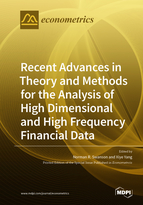Recent Advances in Theory and Methods for the Analysis of High Dimensional and High Frequency Financial Data
A special issue of Econometrics (ISSN 2225-1146).
Deadline for manuscript submissions: closed (30 September 2020) | Viewed by 37400
Special Issue Editors
Interests: financial econometrics; macroeconometrics; time series analysis; forecasting
Special Issues, Collections and Topics in MDPI journals
Special Issue Information
Dear Colleagues,
There have been numerous econometric advances made in the fields of empirical and theoretical finance in recent years. Many such advances were initially spurred by recent technological, computing and data collection innovations. In particular, as computing ability and dataset sizes have increased, both empiricists and theoreticians have focused considerable attention on solving key unresolved issues relating to estimation and inference in the study of large datasets used in financial economics. Examples of topics in which important advances have been made include nonparametric and parametric estimation of models (e.g., simulated method of moments, indirect inference, and nonparametric simulated maximum likelihood, among others), and estimation and inference based on point and density estimators of possibly latent variables (e.g., realized measures of integrated volatility, and estimation and accuracy testing of predictive densities or conditional distributions, among others). Recently, considerable attention has also been placed on the development and application of tools useful for the analysis of the high dimensional and/or high frequency datasets that now dominate the landscape. These tools include machine learning, dimension reduction, and shrinkage based data methods, for example. The purpose of this Special Issue is to collect both methodological and empirical papers that develop and utilize state-of-the-art econometric techniques for the analysis of such data.
Prof. Norman R. Swanson
Prof. Xiye Yang
Guest Editors
Manuscript Submission Information
Manuscripts should be submitted online at www.mdpi.com by registering and logging in to this website. Once you are registered, click here to go to the submission form. Manuscripts can be submitted until the deadline. All submissions that pass pre-check are peer-reviewed. Accepted papers will be published continuously in the journal (as soon as accepted) and will be listed together on the special issue website. Research articles, review articles as well as short communications are invited. For planned papers, a title and short abstract (about 100 words) can be sent to the Editorial Office for announcement on this website.
Submitted manuscripts should not have been published previously, nor be under consideration for publication elsewhere (except conference proceedings papers). All manuscripts are thoroughly refereed through a single-blind peer-review process. A guide for authors and other relevant information for submission of manuscripts is available on the Instructions for Authors page. Econometrics is an international peer-reviewed open access quarterly journal published by MDPI.
Please visit the Instructions for Authors page before submitting a manuscript. The Article Processing Charge (APC) for publication in this open access journal is 1400 CHF (Swiss Francs). Submitted papers should be well formatted and use good English. Authors may use MDPI's English editing service prior to publication or during author revisions.
Keywords
- Empirical and theoretical financial econometrics
- Big data
- High dimensional and high frequency data







